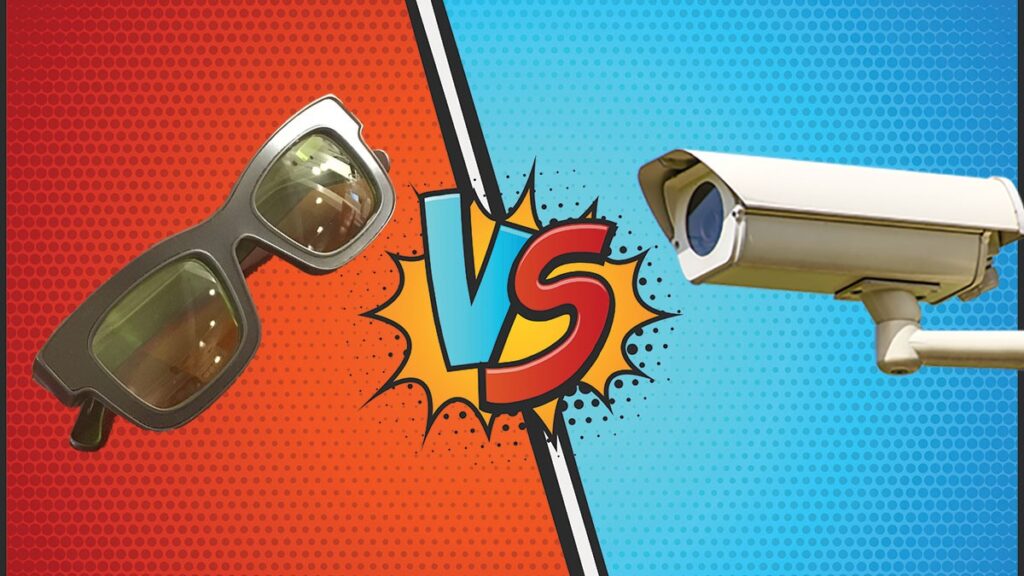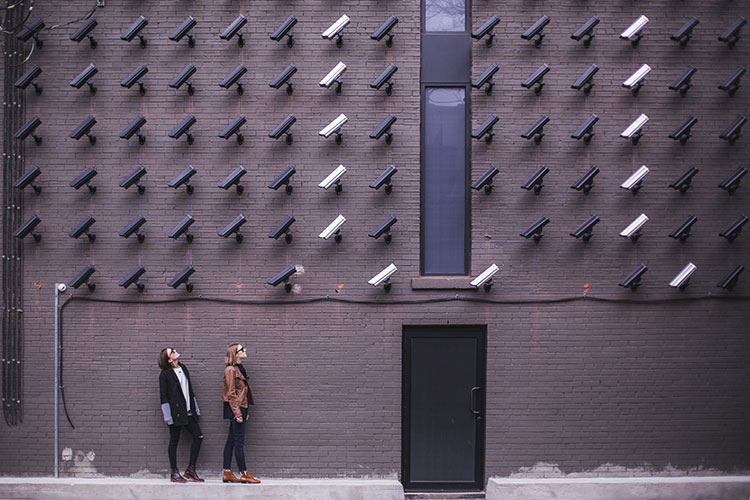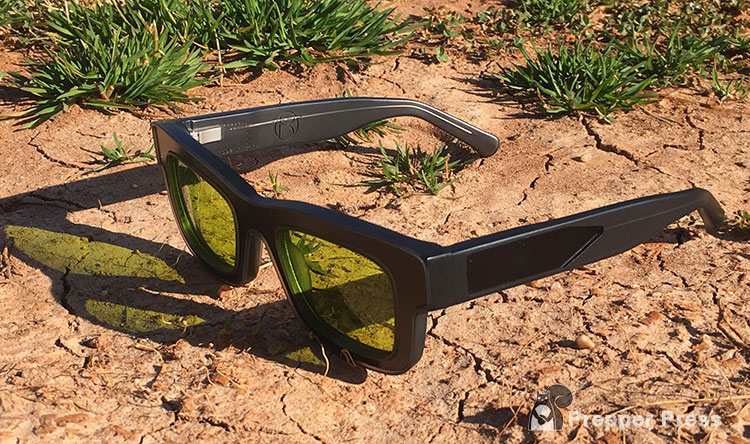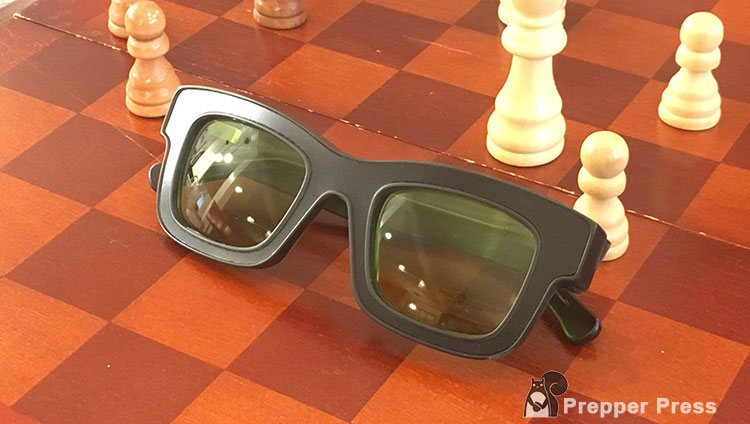
One of the more concerning trends that we have seen over the past few years has been the explosive growth in facial recognition technology. It’s not just the technology’s improvements that’s concerning, but its growing prevalence. It’s become almost impossible to make it through an entire day in the developed world without being exposed to facial recognition tech at some point. If you’re concerned like me, you might be wondering if there are ways to defeat facial recognition. There are, and in this article we’ll look closely at specialty glasses.
Does Facial Recognition Even Matter?
“Some machine read my face – big deal.”
Let’s say you’re a gun owner. Most preppers are. Now let’s say that your apartment is a three block walk from your local gun store. You normally like to go in and pay cash for whatever you purchase there. You’ve seen banks deny processing payments for firearms and their accessories in the past, and you don’t want that to happen to you. You’re also not a fan of some data mining company out there having a digital history of your firearm purchases.
You’re personally a big fan of the AR-15 platform and have spent time learning how to build a few low-cost AR-15s over the past few years. The government will approve your purchase through the federal background check, but the less information you have out there about your purchases the better.
However, if there are cameras along your route – ring doorbells, traffic cameras, or even security cameras within the gun store – the presence of facial recognition technology could very easily undo all of your attempts at improved privacy. You want to limit those opportunities.
7 Ways to Defeat Facial Recognition
I’ve had an interest in facial recognition (rather, how to avoid facial recognition) for the past ten years. As a result, I’ve done my best to stay abreast of the research within the field. For the longest time it almost seemed as if it was a lost cause attempting to fight facial recognition (FR) software. The only option that I felt was feasible was to lobby against its public usage.

Lobbying sometimes seems like trying to break down a brick wall with a bendy straw, so I began searching for other options. Here are 7 ways I found to help combat facial recognition…
1) Anti-facial Recognition Mask
The very first product to ever be released (that I’m aware of) to successfully fight facial recognition was a digitized looking neck gaiter. It had digitized “faces” scattered throughout the mask, making it so that the software can’t determine where exactly somebody’s facial structure is. The software ends up becoming so confused that it can’t register anything whatsoever.
To the best of my knowledge, this product has never been available for sale either. However, there are spin-offs of it that are readily available on Amazon . I wasn’t able to test one for this article, so I’m not sure whether they work or not, but in theory they should. The catch on this is that facial recognition is constantly improving. What was once a good strategy for defeating it may no longer work as well as it once did.
A modern take on the subject that I’ve long wondered over though would be if one wore a neck gaiter style mask that was covered in pictures of actual human faces. In my mind The Founding Fathers would be appropriate. If there are fifty pictures of John Adams, George Washington, Ben Franklin, and Thomas Jefferson scattered throughout a mask, FR should have one heck of a time determining which face to focus on, am I right?
2) The “Surveillance Exclusion” Mask
The surveillance exclusion mask is another conceptual product that (to my knowledge) currently isn’t on the market. It supposedly blocks FR by blurring the lines of your face so that only strips of your image are available to the software, and even then, not enough for it to actually piece together the puzzle.
I don’t see this as a feasible option, however. To begin with, wouldn’t this also affect your vision? I don’t necessarily like the idea of having lines down my face every inch that I can’t see through. It seems like a great way to either trip over something and hurt yourself, or to give yourself a headache.
I hate wearing masks as well, so this would be a problem for me. What happens if you get sweaty or it’s cold outside? Does this thing fog up? And really, if our goal is to maintain our privacy and anonymity, what better way to draw attention to yourself than to wear some idiotic looking face shield?
3) Fake Faces
At the top of the list for creepy-factor would have to be pretending you’re Hannibal Lecter and wearing a fake face. These are readily available for a small fee at URME Surveillance.
The creator of these masks is a privacy enthusiast who has copied his own face onto this cut out which you can then wear. Facial recognition software should then think it’s him instead of you (if it’s able to measure the mask geography).
While this most certainly may be a cheap and effective option, I really don’t like it. To begin with, those who look at you close enough (such as a cashier) are going to know that that’s not your real face. Your lips aren’t going to move when you talk. If I was that cashier I would think I was about to be robbed or in the presence of a serial killer.
And imagine a police officer seeing you. Your problems would quickly mount from there, and I imagine that attempting to convince the officer that you’re a privacy enthusiast who believes that FR for Big Brother-style surveillance is a human rights abuse won’t be very effective. If you’re a defender of privacy, it’s typically in your best interest to avoid having a cop collect all of your data.
4) Strange Makeup Patterns
One of the main ways that facial recognition works is by detecting the lighting patterns that occur on the human face. The cheekbones area exposed to more light (and are thus, lighter), while the eye sockets are recessed, meaning that they are darker areas of the face. FR is built upon this understanding and uses it to determine who you are. This is where anti-surveillance makeup comes in.
One of the current theories of defeating FR is to use strange and bizarre makeup patterns in order to confuse the software. This often includes lightening areas such as around the eyes, while darkening the cheekbones. While perhaps this may work, I don’t put a lot of faith in it. To me, this is a better way to march around looking like a clown (and consequently drawing attention to yourself) than it is to defeat .
5) Specialized Face Jewelry
Right in line with the “well, we’ll just change the shading patterns” line of thought is using specialized face jewelry with the hopes of throwing FR off our scent. It may work, but you will look like you live in The Hunger Games’ capitol.
6) Wear a Hat
Ahhhh, here we have a low-tech option that actually works. Facial recognition can’t do its job if there’s no face to see in the first place! Wearing a hat is not only socially acceptable, but it in no way attracts undue attention in your direction either. I see this as an excellent tool in our toolbox of anti-FR tech. There are a couple of problems when it comes to solely relying upon a hat, however.
To begin with, many FR capable cameras are placed at face level with the express intention of keeping you from being able to avoid their gaze. If you’ve ever been into a self-checkout lane at a local grocery store, or even gone to your local bank, you’ve likely seen cameras that are placed right at face level, or slightly below it.
In such cases, a hat truly becomes useless. So we have to find a way to not only shield ourselves against FR, but to actually combat it when our image is captured regardless. The best option I’ve found of such is next.
7) Specialty Glasses – Reflectacles
This is what I see as the best, least attention-grabbing option on the market currently for fighting FR. Specialty glasses, like Reflectacles, work by blocking infrared (IR) light – the type of light that FR software typically relies upon. That means that when IR is shined in your direction, these lenses will turn completely black, making it so that the computer can’t collect the data around your eyes it needs to determine who you are.

In addition to this, the outside of Reflectacle frames is, well, reflective – to infrared light, that is. This creates a strong glow around your face anytime a picture or video is taken of you by a camera which utilizes IR, making it so that the software can’t get an accurate map of your face geography.
When I discovered this product, I was truly stoked. It was cool to finally find a product that would work without looking like a clown. I ended up getting a pair of the Phantom lenses. They looked natural. Nobody seeing you wearing them was going to think that I was actively evading FR or a weirdo. I’d be able to walk into a crowd without having to worry about the entire room turning to see the tinfoil hat wearing freak. That alone was awesome.
Anytime I get a new product, I like to test it extensively to ensure that it actually does what it says it does. See my prior posts on the Snugpack Scorpion 2 or my post on the Mission Darkness phone faraday cage to see what I mean.
The Reflectacles were no exception. If you’re counting on something to maintain your anonymity and privacy, you have to know that it works. It can be incredibly dangerous to be blindly trusting in a product that doesn’t do what it’s purported to do. To assure myself of Reflectacles’ effectiveness, I ran a few tests.
Reflectacle Tests I Ran
Beating iPhone Facial Recognition
One of the most common forms of facial recognition that we see is with unlocking smart phones. I figured that if the Reflectacles could work here, then they would likely work on other FR tech as well. I found two different people that had that feature activated on their phones and got them to wear the Reflectacles. In both cases, neither of the phones would unlock, no matter how many times that they tried.
This was a major win in my book. If the glasses could block that, then surely they would be able to beat other similar software programs out there.
Beating the Thermal Tracker at My Gym
The next test I ran was what I deemed an even bigger win. Within the past six months my gym has instituted a new thermal/facial recognition tech right at the front desk for when people walk in. You have to stand in front of the camera – it displays the thermal information of your face – and then it either clears or denies you, with those having a high temperature being kicked out. I’ve always hated this.
To begin with, it feels like a violation of HIPAA – if a stranger has access to that particular biometric of mine, what else could they access in the name of “public health”? Is blood type, sexual activity, pheromone level, vaccination history, and respiratory analysis next? What about medical procedures? Do you need to know that as well? It’s always made me angry.

To top off the matter, when you scan in there is clear evidence of facial recognition software at use. At the bottom of the screen your member number, name, and other information is displayed after your face is confirmed. I totally understand a gym needing to know that the people coming through the doors are members, but I also don’t care to have my facial structure, biometrics, and location history/patterns stored in the computer and used in whatever fashion they deem necessary.
Nobody needs to know my daily pattern. So, I checked in wearing my Reflectacles.
I was stunned. There was a clear section of solid black on the screen where the Reflectacles were. No temperature information was getting through whatsoever.
Interview with the Creator of Reflectacles
The best place to find pure water is at the spring. Using that logic, I figured the best place to get information about Reflectacles was from the creator himself, Scott Urban. I asked him a bit about the technology behind Reflectacles as well as where he sees the field of facial recognition developing, both from a tech and policy standpoint. Here is my interview…
Q: Is there a backstory on how you got into fighting facial recognition, its dangers, or the like?
A: My “brand,” if you can call it that, has developed from living the way I do. I’ve been making custom wood eyewear for individuals since 2005 under the name Urban Spectacles. By making custom glasses with my hands, I was able to understand the craftsmanship that goes into the design and construction of eyewear. That’s my self-taught background and I bring the same quality standards to the frames I’m making with Reflectacles.
I never adapted to the trendy changes of technology. I’m still using a flip phone because I don’t need a computer on my phone. I have a desktop for that. When I leave my place, the phone stays at home. I don’t need GPS maps to track me because I know Chicago like the back of my hand from biking all over it. If I need to go somewhere I’m not too familiar with, a paper map still works. I won’t even get into the shift that has occurred with dating apps. Let’s just say I should be seeking a woman in her late 90s at this point because maybe she hasn’t been skewed by this sort of tech yet.
In 2015 I threw all my time into making reflective eyewear as I saw many uses for it. I get bored easily and after ten years of making custom wood eyewear, I wanted a new puzzle to figure out. So, I weaseled my way into making connections with manufacturers and learning all the logistics of running a business. Then in 2016 I made a Kickstarter and I noticed that most people were interested in it for the concept of physical privacy.
I’m not a marketing fool, but I realized that privacy will be the most valuable aspect of the reflective frames that I was creating. From there it was researching what tech was being used and what tech will be used and to discover the best way to defeat it. Sure enough, in 2017 Apple comes out with the 3D IR facial recognition system they call FaceID. My frames from 2016 defeat it and so I go deeper into how to block these systems because I know they will attempt to improve. So far, I believe I am ahead in the cat and mouse game.
Q: Are there different types of facial recognition?
A: I break this down to two main types of facial recognition that are currently being used: 2D and 3D systems.
Two-dimensional systems have been around since the 60s in different forms. It used to be accomplished with people actually measuring the data of the facial measurements by hand. This was the birth, and you can check out Woody Bledsoe if you want the original story. Then around the 80s they started getting more hip to letting the computers do the work with algorithms and they have just advanced from there.
So, the 2D systems rely on flat information and try to extract facial data. It’s going to be a computer program (algorithm) that a person designed to analyze images and videos to try to make a facial match. These systems rely on databases, meaning there must be a stockpile of faces for the system to sort through and try to make a match.
So, our drivers licenses or state IDs are a wealth of 2D information that can be used. These systems are old and rely on guesswork. For example, it may give you 100 possible matches out of the database of, let’s say, 10,000. So, somebody will have to go back and sort through these to narrow it down. There was a good example a couple years back where the NYC police saw a dude on camera who committed a crime and he looked like Woody Harrelson. So they put through WH’s image into their system, narrowed it down so similar looking dudes and I think they found their man. There are plenty of other cases where dudes were arrested based upon 2D facial recognition where it later turned out it was not the correct person.
Then 3D infrared mapping or scanning. This is what Apple’s FaceID uses. They put it on the iPhone X in 2017, but I have a white paper from NEC from 2013 (they make the facial rec systems for our airports and CBP) that discusses how they are working on 3D IR scanning/mapping and how much more accurate it is. And it is much more accurate. It is a 1-to-1 system, meaning that twins won’t even be able to fool it because of very slight geometry differences.
So, the 3D IR facial recognition works by sending out 10ks to 100ks of infrared individual lasers to map the space in three dimensions. It is digitally recreating our 3D space environment in its system. This is highly accurate and can narrow each individual’s face even without a database of supplied images. What this system can do is create a profile for each person’s face and every time it gets scanned into the system, it will make a data point for that string of numbers attached to that particular face. So with the 3D realm of facial recognition, it no longer needs human review to make the matches. Combine this accuracy with machine learning and they have already created the tracking monster.
Q: Do Reflectacles work better against some technologies than others?
A: When creating Reflectacles, my main intention was to defeat the 3D systems because this system is extremely accurate and raises the most concerns about when we are allowed to maintain our privacy from being captured and logged. So far, my frames beat systems like Apple’s FaceID as well as dedicated 3D IR facial recognition systems that were developed by folks in academia working on facial recognition and artificial intelligence.
The fact that my frames’ lenses block infrared from seeing the wearers’ eyes seems to be the most important aspect to fool these systems. Eyes have always been the most important aspect for facial recognition since its beginning and it seems it is still true with the newest forms of the technology.
I would say where Reflectacles may fall a little short is on systems that a person willingly gives over their facial data to begin with, like access control. Also, on the 2D systems in bright day light, since the frames won’t be reflecting or blocking any light, I can see the algorithms still finding a possible match. But again, the 2D system is based on a lot of guess work to begin with.
Q: Do you have other tips on how to fight mass surveillance?
A: Number 1 tip to evade surveillance – LEAVE YOUR PHONE AT HOME. Pull the GPS out of your car. I know it’s not facial recognition, but I don’t understand somebody concerned with facial recognition and they are allowing all of these other forms of tracking.
But if we are speaking of just facial recognition, I would say it is important to be aware and cautious of your surroundings. For example, I recently purchased a 120-year-old German made Parlor guitar from a dude’s house (he didn’t know what it was). But I approached his front porch and saw an Amazon Ring doorbell. I did not get in view of it, and spoke to them through it from the side where it could not see me.
So, by having a bit of foresight and recognition of the tech being used around me, I’m not on that system. This can apply to other areas. To learn about what tech is being used around us, we can recognize it and often times not include ourselves in the database. Another example would be a self-checkout at a store. Don’t use them because of course they are gathering your physical data and logging it into a system. It can help take your physical details off of yet one more system.
Q: We’ve seen that surgical masks no longer hamper facial recognition. Do you see Reflectacles becoming obsolete with improvements in facial recognition technology?
A: I wouldn’t believe the media mentions about facial recognition working on people with masks on. Again, it goes back to the theory of a 1 to 1 match versus a 1 to a 1000 possible match. The less facial data you offer the less facial data these systems can gather. It means less information they can use to make an accurate ‘guess’ with.
So, a mask – let’s say – covers up about 2/3rds of our faces’ data points. That leaves the systems with the eye measurements, brow lines, temples, forehead, hair line, etc. With Reflectacles on and a mask, now we are taking out the eye space measurements and even the brow line. So if you think a system that recognizes somebody based upon their forehead only is accurate…well. We will see where it all goes. I strongly believe it is mostly based upon the eyes. My man Woody Bledsoe would agree.
Q: If wearing Reflectacles, will I be able to unlock an iPhone with facial recognition for the password?
A: As we speak, no you will not be able to unlock Apple’s FaceID with your face as the password while wearing Reflectacles. FaceID is first programmed to “look” for eyes. If the algorithm doesn’t see eyes (one eye works), then it does not send off the 30,000 infrared lasers to analyze the facial dimensions in 3D space to allow for a positive match. You can easily test this by trying to unlock Apple’s FaceID while closing your eyes. It will not log in.
So, that is what my frames are doing by not allowing infrared to pass through the IR-blocking lenses, and also by reflecting those infrared lasers back to the sensors on the phone to further confuse the data. If Apple wants to defeat my frames in the future, they will need to become clever and retool their facial recognition systems to not rely on iris or eye space measurements.
Q: Are there other products to fight facial recognition in the works?
A: I know a dude who is working on a very interesting concept with blocking Automatic License Plate readers. I’m actually pushing him to start a business on the concept, because if his idea works, it will be interesting. I meet folks like this with ideas in email.
And yes, I enjoy encouraging them to follow through with their concepts. I offer thoughts and help when I can, but I say the more people working for products that maintain privacy, the better. I have a concept for a plate idea, but honestly, if his works out, it will be better than mine.
I say we should all share concepts in this realm and not be like older forms of business where they steal ideas to profit off another. We should all help each other grow and develop to work against tech that takes away our privacy, especially since we don’t sign any TOS in these cases. They just use it on us. Almost like open-source product building.
Q: Is there the potential of different Reflectacle frames in the near future?
A: Yes, there will be much more coming. I’m starting a new production run currently with new options. One will be a ‘fit over the glasses’ model which is like a goggle of sorts that fits over your regular frames. This is what I’m currently wearing. They block out a lot of facial data, they look like something out of a movie from the 80’s that was set in 2042, and I think they are a perfect sign of the times in terms of design and function. There will also be new acetate color options for the Phantom, Ghost and IRpair models. These will all be available this summer.
After that, I’ll introduce an oversized model for Phantom and Ghost to cover a larger area of the face. Models for kids are next as a lot of parents are reaching out about keeping their children off of these facial recognition systems. Then there are the concepts that I won’t mention at this point. Imagine where tech will be in 5-10 years and that is what I am creating to help people maintain their selves from the tech. Think augmented reality, autonomous cars, automated everything. And it all uses Infrared.
Final Thoughts
Facial recognition is a growing scourge within modern society, and you’re only going to see the abuses generated by it to grow worse. Exponentially worse. As such, I think it’s imperative to take the steps to protect your identity while you’re out and about. History has proven time and time again that you can be a normal citizen one day, and then automatically deemed a felon the next – not because you’ve broken any prior law, but because a law was passed within that timespan that made a regular hobby or interest of yours illegal.

Whether we’re talking about owning guns, buying bulk ammo, 3D printers, crafting your own holsters out of leather, or utilizing ham radio, you should be doing everything in your power right now to protect your payment information, your browser history, and even your own face from surveillance tech.
Facial recognition is one of the most potent forms of this, and you need to be able to fight it. Hopefully this article will have given you some of the first thoughts for what steps you need to take next.
Do you have other concerns regarding facial recognition? Are there other ways to combat it that you’ve discovered? Are there recent news stories that are relevant? Let us know in the comments below!

7 comments
Would the easily available mirrored glasses have any effect on the facial recognition technology? Don’t have a newer I-phone (don’t want one ) so no way to test it personally.
Jim
No, none. The mirrors reflect visible light, not infrared light. That means facial recognition tech can see your eyes clearly through the mirrored lenses.
I just bought a pair and I can’t wait for them to arrive. I have a newer iPhone but I blacked out the FR lenses with electrical tape so, my faceID doesn’t work. I will be wearing my reflectacles everywhere I go from now on
Wow your testing is… Moronic. IPhone facial recognition is basic, like… Verrryyy basic. It’s to unlock a damn phone. Tricking it into thinking your another person can be difficult. But stopping it recognising you is something a literal child can do. Also the gym test? Are… Are you dumb? It’s a fancy ir thermometer… Literally the most basic device imaginable. Those glasses will do shit all on actual facial recognition tech outside of fooling cheap gimicy toys.
Well, James, what would you suggest?
I notice James never responded.
Just wanted to say that my name is dalas verdugo and I was the person who originally introduced this idea to Scott Urban. He told me that we could work together and he would share a portion of the profits with me. Unfortunately, he ended up taking my idea, claiming it as his own, and stopped responding to my communications. He never mentions my name and acts like he came up with the idea himself. Very disappointing.